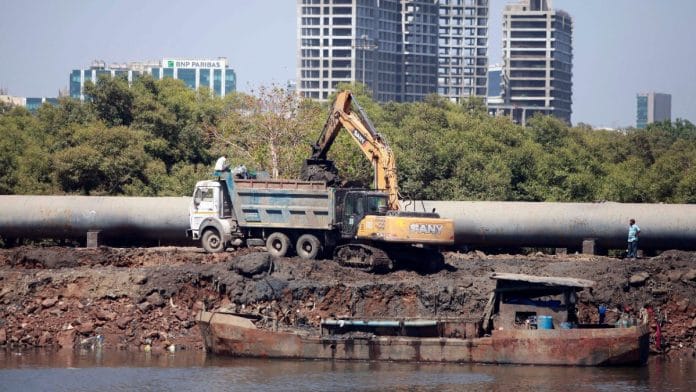Mumbai: Each year, desilting of small and major drains, as well as that of the Mithi river, precedes the onset of monsoon rains—almost like clockwork. This time Brihanmumbai Municipal Corporation (BMC) has introduced a new element to the process, artificial intelligence (AI).
Artificial intelligence, says the BMC, has been useful in flagging any fraudulent practices by contractors. “To clean nullahs every year, technology was used for transparency and efficiency but this year, an added feature, AI, was used and we are definitely seeing its benefit though it is still a work in progress,” IAS officer Abhijit Bangar, currently posted as additional municipal commissioner (Projects) at BMC, told ThePrint.
Silt is a natural sediment, while muck includes sediment along with debris, plastic, solid waste, etc.
The civic body said that about 25 different agencies have been roped in, on a two-year contract, to desilt nullahs and rivers across the city, with work orders totalling upwards of Rs 450 crore. BMC even identified a contractor in M/E ward who was found mixing silt with muck. Use of AI allowed the system to trace the contractor through the vehicle number and resulted in his termination and subsequent blacklisting.
Also Read: Fed up of Bengaluru roads, doctor drags civic body to court, seeks Rs 50 lakh in damages
Introduction of AI into the system
Mumbai has a network of nearly 4,000 km of nullahs and drains. These include major drains (more than 1.5 metres wide) and minor drains (less than 1.5 metres wide). By 31 May each year, BMC has to complete the desilting work—removing muck, silt, garbage—to avoid waterlogging.
The civic body said this year it is using an AI dashboard to monitor progress on a daily basis. The process of silt removal involves removal of silt from drains, loading it onto a truck, weighing the truck, and then dumping the silt.
One of the objectives of the AI dashboard is to ease the process of weighing.
When the vehicle comes near the weighing machine, the machine reads the number plate and links it to the contractor who is already in the system. This is the point where the exact date and time of the weighing is recorded.
The machine then uses images of the vehicle to confirm the presence of silt.
Earlier, many contractors would cover the truck with tarpaulin, but according to Bangar, with AI now part of the process, “the system will not accept the picture with tarpauline”. Until last year, the contractors would upload only pictures on the platform, but they have now been asked to upload both pictures and videos—which are then analysed using AI.
This too is challenging, given the amount of data, he added.
Each day, hundreds of images and videos are uploaded across the portal and analysing them in real time is cumbersome. Bangar said the civic body has introduced a video analysis software to analyse this footage and flag any anomalies. For instance, the system would reject any videos that aren’t shot from a particular angle as instructed by officials.
“Sometimes contractors upload ghost images and videos. The system is trained to identify such fake, ghost images. Right now the accuracy of the system here is not 100 percent but we are observing that it is progressing,” said Bangar. According to BMC data, contractors have uploaded 3 lakh videos and photographs to the civic body’s portal to date.
Bangar added that all nullahs are geo-fenced which makes it easier for the system to identify any anomalies. In one of the wards in the western suburbs, for instance, the system helped the civic body identify that, in a small area of 20×20 metres, 97 vehicles were seen as loading silt. This was flagged by the system.
What we realised is contractors shot the video at a different location and were uploading it from somewhere else, which is not allowed, said Bangar.
So far, BMC has spotted anomalies in 1,200 trips and expects to collect Rs 4 crore in fines against these violations. “Because of the system and questions being asked, contractors have become very aware and cautious and higher transparency is achieved.”
(Edited by Amrtansh Arora)
Also Read: Dust storms hit Delhi & Mumbai, then warnings came — why they couldn’t be predicted in time






